One of the most reliable and effective hydroponic systems available to gardeners is the ebb and flow (or flood and drain) hydroponic system and going vertical just makes for more veggies in a smaller footprint. Like other hydroponic systems, ebb and flow systems aim to maximize nutrient uptake and available oxygen in the root zone. A properly operating ebb and flow hydroponic system will rival any other high-performance hydroponic system in both the speed of growth and overall yield. A closer look at the principles of an ebb and flow system will illustrate how this fairly basic hydroponic system has found a permanent place within the indoor growing community with both hobbyists and commercial growers.
Ebb and Flow Hydroponic Systems – How They Work (Both Vertical and Flat Types)
Ebb and Flow is one of the most widely recognized hydroponics systems out there. It is intermediate level in difficulty, relatively low-cost to set up, and extremely versatile.
This method allows you to easily alter your garden, adding or removing plants as you wish without affecting any of the surrounding crops. Like other methods, the basic concept is very simple–plants are placed in a tray, which is periodically filled with nutrient-rich water pumped out of a reservoir below. Gravity then returns the water to the reservoir to be reused.
This system seems complex to beginners because it involves so many different components, but they all come together quite easily and can be assembled in very little time. Once assembled, this system needs little maintenance and produces plants efficiently with very little electricity or water use.
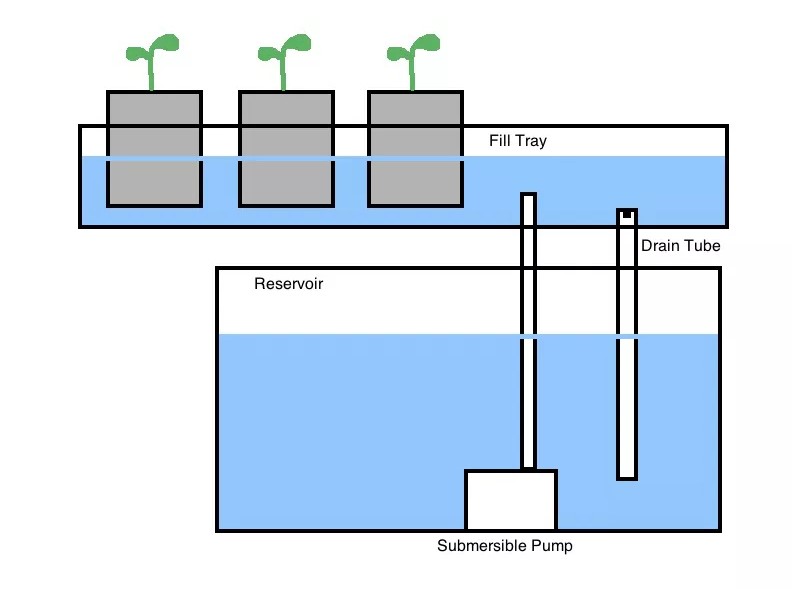 An ebb and flow system relies on intermittent water delivery (flood) to a plant or series of plants held in an inert medium. The medium is primarily for stabilizing the plant and is not required to have any nutritional value. In a true hydroponic ebb and flow system, all nutrition is provided by the nutrient solution. The most common media used in ebb and flow systems include hydroton (clay pebbles), stone wool and rinsed gravel, but any inert medium that doesn’t float will suffice. The ebb and flow system is one of the simplest hydroponic systems to set up and use, but it still takes some experience and effort to master. There are two common ebb and flow configurations used by indoor horticulturists: a tray and reservoir configuration (single pump system) or an individual module configuration (dual pump system).
An ebb and flow system relies on intermittent water delivery (flood) to a plant or series of plants held in an inert medium. The medium is primarily for stabilizing the plant and is not required to have any nutritional value. In a true hydroponic ebb and flow system, all nutrition is provided by the nutrient solution. The most common media used in ebb and flow systems include hydroton (clay pebbles), stone wool and rinsed gravel, but any inert medium that doesn’t float will suffice. The ebb and flow system is one of the simplest hydroponic systems to set up and use, but it still takes some experience and effort to master. There are two common ebb and flow configurations used by indoor horticulturists: a tray and reservoir configuration (single pump system) or an individual module configuration (dual pump system).
Basic Components
The main two components of any ebb and flow system is the plant tray and the reservoir.
The Plant Tray
The plant tray—also called a flood tray—is a large, shallow container on a tall stand, in which you place your plants. Plant your seedlings in half-gallon perforated pots filled with a growing medium such as Perlite. The pots that your seedlings are in should be about twice as deep as the flood tray. The flood tray is pumped full of nutrient-dense water from the reservoir below, which flows up through the bottom of the pots to the roots of the plants. The water is then drained back out, allowing the roots to become completely dry and oxygenated before flooding again.
The Reservoir
The reservoir is placed directly below the flood tray’s stand. It is connected to the tray via a fill tube and a drain tube. The fill tube attaches to a submersible pump with a timer, which controls the flow of water up into the flood tray. The drain tube allows gravity to pull the water back into the reservoir after flooding so that the water can be reused. You can use the same water for about a week at a time, making sure to renew the nutrients every time you change the water. The submersible pump with a timer allows for a lot of control in this type of system because you can customize the length and frequency of watering based on your gardens’ needs.
Here is an excellent video, good for the “DIY Crowd” that shows exactly how it’s done:
System Cleaning
Because of the constant movement of water, it is important that you thoroughly scrub, clean, and sterilize your growing medium, reservoir, pots, and plant tray in-between seasons. It is not uncommon for harmless algae to grow on these surfaces, but improper cleaning can lead to mold and insect infestations that could ruin your future harvest.
Please note that this site is supported by affiliate marketing which means that a small portion will be paid to maintain this site from any purchases made through it. This in no way affects the price of the products on this page.
Foody Vertical Gardens
As you can imagine, growing an ebb and flow hydroponic system could take up quite a lot of room. Foody Vertical gardens have found a truly effective means of giving you all of the benefits of an ebb and flow system without using large flat spaces. This saves space and allows much more food to be grown. The unit below could easily support the vegetable needs of a family of four and takes up very little floor space.
Check these out on EBay HERE.
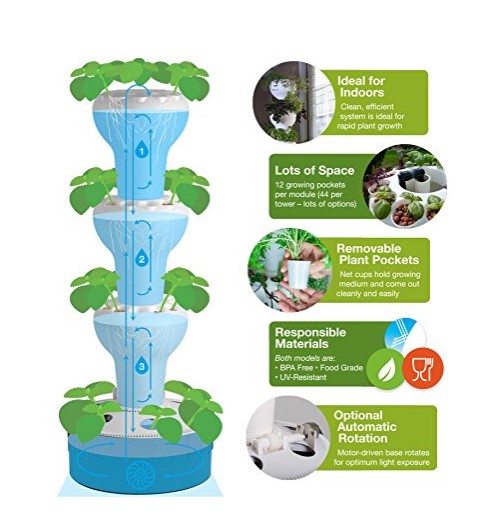
How the Foody Vertical Garden Works
Essentially this vertical hydroponic system works the same as how a toilet flushes, thereby giving it the “ebb and flow”. Water is pumped from the bottom basin up to the top pod. Each Pod is connected to the pod below it by some basic PVC pipes. When the water fills up the first pod and reaches a certain level it starts to flow through the PVC pipe down to the pod below creating a suction that essentially sucks the water out of the top pod down into the pod below it.
It’s the same principle as to how a toilet flushes. When you flush the toilet all it does is put more water into the bowl until it fills up enough to create a siphon that pulls the water out of the bowl and flushes it down the pipes. The cool thing about this is that the roots of the plants get soaked in water for a minute or so then once the flushing process happens, it sends the water down to the next pod. The roots are then exposed to air until it fills up again. The process keeps repeating itself. You can hear the water but it’s like the sound of a small waterfall.
10 Benefits of Vertical Hydroponic Ebb and Flow Systems
1. No Weeds
Of course not! You only grow what you plant – WHAT a relief!
2. No insect pests
Plants grown indoors in any kind of hydroponic system will not attract insects unless you manage to bring them inside with you. This is another reason why cleanliness is essential. Also, use separate gardening tools when tending to your indoor hydroponic plants than with your outdoor vegetable plants so as to avoid contamination.
3. Garden All Year
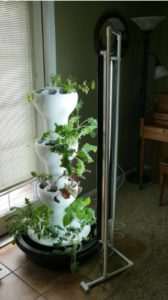 Hydroponic gardens allow you to grow indoors regardless of the season. Just make sure you put your garden near a well-lit window or use a light stand. Since this vertical garden slowly rotates, light is distributed to all plants without the need of turning it. Light stands are available in a stand containing two four-foot-long T5 fluorescent bulbs but I would also recommend supplementing with extra LED lights as shown below. The light stand and T5 bulbs can be found on Amazon HERE. (This is temporarily unavailable on Amazon at this time.)
Hydroponic gardens allow you to grow indoors regardless of the season. Just make sure you put your garden near a well-lit window or use a light stand. Since this vertical garden slowly rotates, light is distributed to all plants without the need of turning it. Light stands are available in a stand containing two four-foot-long T5 fluorescent bulbs but I would also recommend supplementing with extra LED lights as shown below. The light stand and T5 bulbs can be found on Amazon HERE. (This is temporarily unavailable on Amazon at this time.)
Additional LED lights that I would definitely recommend: 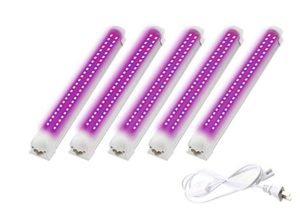
Darlene’s Tip: These can easily be mounted on the light stand for the vertical garden and will give full-spectrum lighting for MUCH better results. These are available on Amazon HERE.
4. Educational
Hydroponic gardens are clean and “hands-on”, and a great tool for the classroom or your own kids. Growing with a vertical hydroponic system is a simple and super way to learn about plants, nutrients, and lighting without worrying about the weather, pests or weeds.
5. Decorative and Attractive
Vertical gardens can be placed almost anywhere inside your home or on your deck/patio, and they are wonderfully productive, so you can count on good looking (and smelling) herbs, flowers and greens all year round.
6. Less Bending Over
Vertical gardens can be placed almost anywhere inside your home or on your deck/patio, and they are wonderfully productive, so you can count on good looking (and smelling) herbs, flowers and greens all year round.
7. Space-Saver
Most vertical towers only need 2 to 3 feet diameter of floor space. Systems like the Foody Tower can grow 40 to 66 plants in a 24″ circle of floor space: The bottom line is productivity vs space. This is where vertical gardening is set apart from any other type of gardening.
8. Move Indoors or Outdoors
Stackable vertical gardens like the Foody 8 can easily be moved in or out of the home, which is good for certain plants that thrive during the warmer months.
9. Uses Less Water and Nutrients
Believe it or not, hydroponic systems actually use much less water and fertilizers than traditional gardens for the same amount of production … you’re not losing as much to evaporation and the soil. In fact, systems like the Foody Tower use just 10% of the water normally used in an outdoor garden. This is why vertical hydroponic towers are catching on in commercial greenhouses and for rooftop installations.
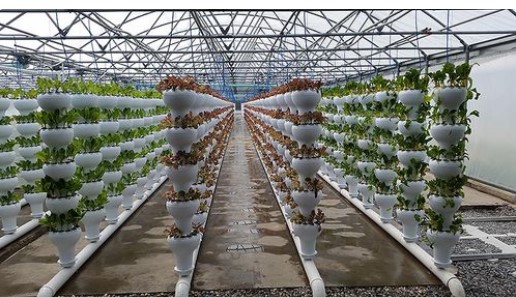
10. Less Mess
Because a hydroponic system uses no soil, you won’t have to muck about in the mud and dirt.

Conclusion – Ebb and Flow Hydroponic Systems – Go Vertical!
I just love the idea of incorporating an ebb and flow hydroponic system with vertical gardening. It’s a brilliant idea for all of us to grow our own fresh food all year round. As more people move from the rurals and into small urban spaces, this unit is the perfect solution for those with little space. We all know the costs to our environment of transporting food long distances to the supermarket, not to mention the degradation of quality in doing so. This system provides the perfect solution to ensure small scale gardening and the absolute freshest produce all year round!
Please join the conversation! I would love to hear what you think of this post so leave your comments below. Don’t forget to press follow so you don’t miss my up-coming blogs!
Related Posts
Conventional vs. Organic Hydroponic Nutrients


0 (0) Are “Organic” nutrients really better for your system or for your customers? Find out in this video from…
Can You Profit From Hydroponics?
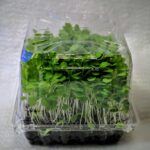

5 (8) Did you hear the story of a farmer who started growing strawberries? Yes? But, do you know he…
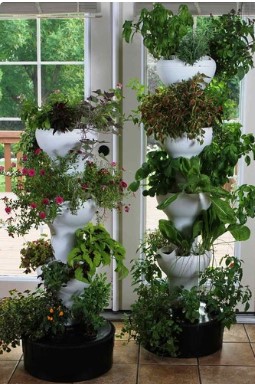

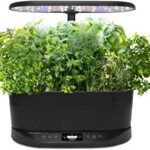

Oh my goodness! What a timely post. I’m a beginner whose greatest gardening achievement to date is having kept my plants alive for more than a year and I’ve been thinking of the best way to arrange my indoor plants (I hesitate to call them a garden as there’s not very many yet) in the small space we call our home.
I was also wondering why we were having some problems with insect pests. We used to have an outdoor garden and an indoor garden and I never thought about contamination at all. Then we moved and I guess we took them with us.
Total newbie question (so I’m sorry in advance): will this work for small fruit trees too?
Hiya Kevin and Jade – yes, cross contamination from outdoor tools to indoor tools is something that slips right by some people. Some die hard hydroponics growers will even have a separate set of clothing on before going near their indoor growing plants.
You *could* put small fruit trees on the top of this unit. If you put them on the bottom they would grow and tend to shade the other plants. Once they got to a certain size, though, I think you would want to/have to move them to a larger set up than the Foody would have. However, if you were going with the tray type DIY system then YES, small fruit trees would do fine. Just make sure you keep putting them in larger and larger pots as their root systems grow. The only limiting factor would be the height of your ceilings!
Good luck with your growing endeavours!
Oh dear, this seems a bit complicated, but at the same time it looks very intriguing! I definitely want to find out more and I also wonder if there is like a more compact system that I could use? Especially as I’m living in a one-bedroom house it’s not so convenient for me to put a lot of plants in a large space (which I don’t have)
Hi there Virendra! I can definitely feel your pain. Check out my smaller solutions on my other blog post here:
https://myindoorgrowsystems.com/aeroponic-grow-systems-indoor-growing-and-more-with-aerogarden/
Thank you for your comment!
Hi
I am mostly interested in hydroponics for environmental reasons. I see that commercial agriculture in our country (New Zealand), despite its clean/green image, has ruined the ecology. New Zealand is one of the most deforested countries in the world. I believe that a move towards hydroponic gardening in any country will allow the environment to recover. Hydroponics, as well as a move towards eating less meat, will be the only way that generations to come will have a standard of living that our parents enjoyed.
Thank you so much for your post
Aaron
Hi Aaron,
Thank you for your comments and I couldn’t agree with you more. I live in Canada and I would say that we would rival NZ in deforestation. There is nothing like growing your own food and the health benefits of eating food you have just picked are unquantifiable.
Thank you for your post. The ebb and flow hydroponic systems is the wonderful way to establish a home garden. My wife and I love plants. We have a home garden, but grow the plants individually. The tasks are so daunting and reaching our limit to deal with our work.
I think that the ebb and flow hydroponic system is the solution for us to improve our indoor garden. You have brilliant ideas that we could grow vegetables, which make it possible for us to enjoy the real fresh vegetable daily. It need some investment. Do you know how much it cost to have the ebb and flow hydroponic systems? We could start from a small one and gradually increase our capacity.
It is kind of you sharing such nice system with us,
Hi Anthony and thank you so kindly for your comments. Amazon’s prices run from $!49.50 to $374.11 (they are actually on sale right now). If you go straight to the Foody web site at https://foodyverticalgarden.co… you will find more options – including an intriguing aquaponics option if you want to let the fish fertilize your plants!
This would be ideal for people in flats where gardening in impossible. My mum has lived in a flat for the past 21 years and this would be ideal for her. She loves plants and she said “It’s the sign of a happy home” bless her.
Thanks to this post mums Christmas is sorted now.
Thank you for the post. 🙂
Thank you Etana! I’m glad this took away some of your Christmas stress – not to mention your mum!
This is by far the most beautiful hydroponic system I have seen. Hydroponic system is a very useful product of engineering and inventions that is helping a lot of gardeners and hobbyist. I love the Foody vertical garden. Very stylish, neat and organized that is so pleasing to the eyes. It’s just a bit expensive for me but for some hobbyist then this is a good fit for them.
Hi Gillian,
Thank you so much for your comments. Yes, if this is purely for a hobby and beauty i can see where it might be a tad expensive. If, however, it is for serious food production then it will pay for itself many times over.
Hi Darlene,
I am very interested in your recent post regarding the Ebb and Flow hydroponic system, this is a very fascinating post because I was looking for this exact product a few months back as I wanted to grow food vertically but I had no idea how to go about it, I wish I had read your post back then because I am limited for space, finally after reading your content I have a better idea on how to approach this project, thanks for taking the time to share these details,
I am making notes this evening and can’t wait to start ordering, especially the LED lighting you recommend using the links you provided, thanks.
James
Thank you so much, James! I am so glad that I was able to help!
I live with my mother she has lots of plants that she grows we have red soil in the yard so nothing grows as fast as it should I like the ebb and flow hydroponic system because it does most of the work for you it’s at ease, I don’t have to literally labour. I’ve grown healthy aloe Vera plant for my grandma’s arthritis and detox from it. I’ve grown various plants too from it. It’s very helpful and efficient!
Thank you for your comment. Yes, I think that Aloe Veras are one of the toughest plants alive and will grow in almost anything. Thank goodness for that fact since they have so many healing properties for us! Yes, an ebb and flow system will definitely grow plants of all kinds faster and with more nutrition and health benefits. All my best to you!
Wow! Such an interesting read this was for me. I love gardening and planting but due to my work’s stress, I don’t have time for it but I have a cousin who does engage in it and it would be more than a pleasure for me to share this post to her. Though I’m not sure she has ever tried the hydroponic system before but it would make it all the more interesting for her. Thanks
Thank you for your comment, Stepho. I hope that your cousin finds it useful!
Your site is well put together. Simple, informative with excellent use of illustrations. I think it is coming along very well for a young site with a lot of comments that show interest. The content even gives me an interest I didn’t even know I had. I didn’t scrutinize every littles aspect of the content, but I did notice only 1 affiliate link. I would suggest more affiliate links. It seems you’re passionate about your niche. So to me it wouldn’t come off spammy. You’d simply be directing people to the tools and products they need to create what you’re teaching them. I think you could use that to your monetary advantage.And since I am new to the site and interested, direction to “build your own” kits and resources would not come off salesy. You have the info and value to back product recommendations.
Thank you for the tip, Mark. I was thinking the same as there are certainly a few things I would add to this system. I will update accordingly. Thank you again for your constructive criticism!
What a clever way to garden, Darlene.
This vertical grow system is genius. I’m impressed and inspired.
I do have small traces of gardening in my genetic makeup and I have tried gardening a few times with good success. Your post has rekindled my interest. I love the indoors concept and the year round idea, even more.
No pests, and greater environmental control add more value. I’m thinking of herbs.
What are the easiest herbs to grow with this system?
Is this a good method for various tomato varieties?
Thanks, Paul
Hiya Paul! I’m so glad to inspire you! ANY kind of herb would grow very well. Also, think leafy green veggies like lettuce, kale, chinese greens, swiss chard, etc. Just beware of any veggies that grow too high like some of the tomato varieties as they will grow up and up and end up shading the vegetables above them. Field tomatoes would do well.
Happy gardening!
Oh my God, this is absolutely breathtakingly beautiful!
i have always wanted to own an indoor garden, but didn’t know how to go about it. Plus, was also a bit sceptical due to the mud or soil etc that I would have to deal with.
But, now that I have come across this article that went in-depth on the ebb and flow hydroponic system, I can definitely see myself owning an indoor garden very soon.
I especially love the vertical installation because it would serve as an indoor ornaments as I display by beautiful planted flowers and also my healthy planted all year round vegetables. Oops, I’m getting so excited already.
Bookmarked this is to show my sister as she would definitely love this idea as well.
Thanks for sharing this practical concept with the world. Keep up the good work!
Thank you so much, Tohin! I have one of these and I can tell you it works like a charm and is really a beautiful addition to the room! I hope that your sister and you enjoy!